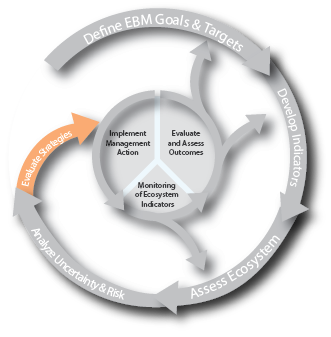Evaluating management strategies is the fifth step of the NOAA Integrated Ecosystem Assessment (IEA) approach and builds off information from the previous steps. Management Strategy Evaluations (MSE) evaluate the potential outcomes of alternative management actions on ecosystem components (natural and human) and identify trade offs within management objectives. MSEs do not prescribe management approaches but rather inform managers which strategies could be the most useful in achieving their objectives.
Benefits of Evaluating Management Strategies
A valuable aspect of conducting a MSE is identifying trade-offs resulting from different management scenario. There is often no one “silver bullet” management alternative.
Identification of trade-offs can help managers:
- recognize and balance potential conflicts between social, economic, and ecological objectives
- make decisions in a more balanced way that accounts for stakeholder objectives
- consider which management scenarios result in trade-offs that best met their objectives
- identify management actions that will be more likely to minimize risk identified in the previous step
- Identify ecological and social processes that influence future ecosystem conditions
This allows for more informed decision-making and balanced outcomes of management across objectives. By elucidating tradeoffs and evaluating a range of potential management options, managers can make a more informed decision with the most beneficial outcome.
Approaches and Tools to Conduct a Management Strategy Evaluation
Management Strategy Evaluations within the NOAA IEA approach can be implemented using qualitative or quantitative approaches. Selection of which approach is most appropriate should be informed by stakeholders involvement, type of management objectives, the Socio-Ecological System of interest, and the availability of data.
Qualitative approaches to MSE: Qualitative approaches often begin with the development of a conceptual model (Step 1 of an IEA) that map the linkages between ecosystem components. This approach is particularly useful when you are unsure of the quantitative relationships between ecosystem components (Harvey et al 2016).
Some of the tools to carry out qualitative management strategy evaluations include:
- Qualitative Network Models
- Bayesian Belief Network
To see an example of using a qualitative network model go here.
Quantitative approaches to MSE: Quantitative methods use quantitative performance metrics to assess trade-offs in management strategies.They also require first defining the ecosystem components and relationships between those components.
Some of the tools to conduct quantitative management strategy evaluations include:
- End-to-end ecosystem models such as:
- Atlantis
- Ecopath with Ecosim
- OSMOSE
References:
- DePiper et al (2017) Operationalizing integrated ecosystem assessments within a multidisciplinary team: lessons learned from a worked example
- Weijerman et al (2017) Evaluating management strategies to optimize coral reef ecosystem services
- Harvey et al (2016) Using Conceptual Models and Qualitative Network Models to Advance Integrative Assessments of Marine Ecosystems
- Kaplan and Leonard (2012) From krill to convenience stores: Forecasting the economic and ecological effects of fisheries management on the US West Coast
- Kaplan et al (2012) Screening California Current fishery management scenarios using the Atlantis end-to-end ecosystem model


